Landlord letter to tenant template
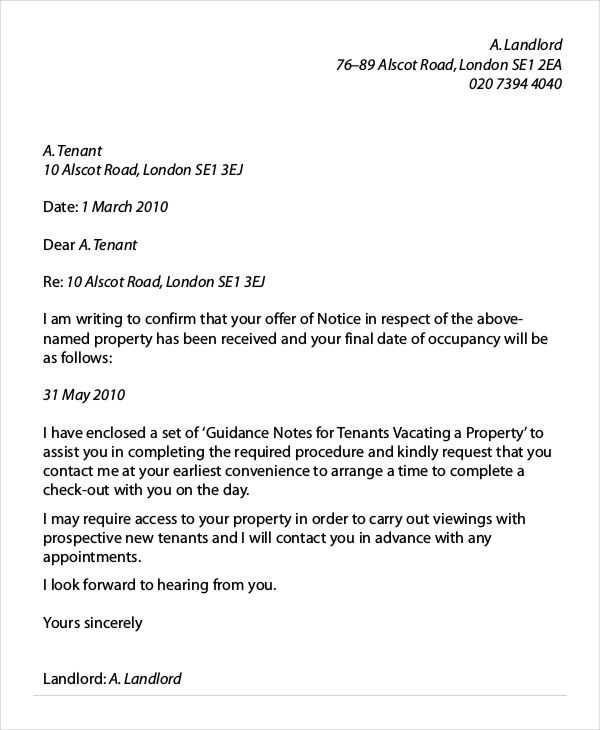
A clear and polite letter to your tenant can resolve many common issues in rental agreements. Whether it’s about a maintenance request, lease renewal, or addressing overdue rent, the tone and content of your letter set the stage for effective communication. Keep it concise, direct, and respectful.
Start with a professional salutation, addressing the tenant by name. This shows that the letter is personal and directed to them specifically. When describing the matter at hand, make sure to include relevant details like dates, amounts, or terms from the lease agreement to avoid confusion.
Be clear about your expectations, whether you’re requesting something from them or providing them with information they need. Use a positive, solution-oriented tone to encourage cooperation. If needed, offer a follow-up or a way for the tenant to contact you for clarification.
Conclude with a polite closing. Reaffirm your willingness to work together and provide your contact information if necessary. This approach ensures a smooth and professional exchange between you and your tenant.
Here’s the revised version:
Start by addressing the tenant directly with a friendly tone. Acknowledge the issue clearly and state that you are providing a solution. Make sure the letter is specific to the situation and focused on the key facts. For example, if there’s a repair needed, describe the issue in a simple way and outline the plan for fixing it. Always be clear about any actions the tenant should take, such as preparing the property or contacting you for access.
Keep the tone professional but approachable. Include any relevant dates for repairs or inspections, and specify the next steps for both parties. Acknowledge the tenant’s cooperation and express your commitment to maintaining the property. End by encouraging the tenant to reach out with any questions or concerns. Avoid any unnecessary details or unrelated issues.
- Landlord Letter to Tenant Template
A well-crafted landlord letter establishes clear communication with tenants, fostering a positive relationship and addressing concerns professionally. Here’s a template that you can adapt to fit your situation:
[Your Name] [Your Address] [City, State, ZIP Code] [Email Address] [Phone Number] [Date] [Tenant's Name] [Tenant's Address] [City, State, ZIP Code] Dear [Tenant's Name], I hope this message finds you well. I am writing to [reason for letter, e.g., notify you about a repair, remind you of rent payment, address a complaint, etc.]. [Detail the situation clearly and concisely, including any actions required from the tenant or steps being taken by you.] Please feel free to reach out if you have any questions or need further clarification. I appreciate your attention to this matter and your cooperation. Thank you for your understanding. Sincerely, [Your Name] [Your Title or Position, if applicable]
Modify the text as needed to address specific situations or concerns. Keep the tone respectful and the information clear to ensure smooth communication.
Start your letter by addressing the tenant using their full name. This helps maintain a professional tone and avoids any confusion. If you are addressing multiple tenants, use their names in a clear, organized manner.
After the salutation, briefly introduce the purpose of the letter in the first few lines. For example, if you are writing regarding an issue with the property, state the matter directly to avoid ambiguity. Be straightforward and clear.
Here’s a sample format:
| Sample Format |
|---|
| Dear [Tenant’s Full Name], |
| I hope this message finds you well. I am writing to inform you about [specific reason for the letter]. |
Using a direct yet polite approach helps ensure that the message is received clearly, which is key to maintaining a good landlord-tenant relationship.
Clearly state the rent amount, payment frequency, and due dates in the lease agreement. Specify the day of the month rent is due and if there’s any grace period before a late fee applies.
- Set clear terms for late fees: Define the penalty for late payments and the timeline for when late fees begin to accumulate (e.g., after five days).
- Outline the acceptable methods of payment: Include whether payments can be made via check, bank transfer, or online platforms, and specify any preferred methods.
- State whether partial payments are allowed: If not, clarify that full payment is required by the due date to avoid penalties.
- Explain consequences of missed payments: Detail the steps taken if rent is not paid on time, such as sending reminders or initiating formal action after a set period.
- Offer clear instructions for submitting payments: Provide your tenants with clear instructions for each payment method to avoid confusion.
By specifying these terms upfront, tenants can plan their finances accordingly, and you can ensure smoother rent collection without misunderstandings.
Send written notifications at least 24 to 48 hours before starting any maintenance or repair work. This gives tenants enough time to prepare. Be specific about the date, time, and expected duration of the work. For example, “We’ll be replacing the kitchen sink on Thursday, February 1st, between 9:00 AM and 12:00 PM.”
Clarify the nature of the repairs or maintenance. If there are any disruptions, like water or electricity shutoffs, mention these as well. Clear communication will reduce tenant inconvenience and foster a positive landlord-tenant relationship.
Always include contact information in case tenants have questions or need to reschedule the work. Reassure them that you will do your best to minimize disruptions.
In case of emergency repairs, inform tenants as soon as possible, explaining the urgency and potential impact. If access to their unit is required, request their permission politely and provide a timeframe for completion.
Clearly identify the specific lease violation that has occurred. Provide details of the action or behavior that violated the terms, including dates, times, and relevant clauses from the lease agreement. Make sure to stay factual and avoid any emotional language.
State your expectations for how the tenant should address the violation. For example, if rent payments are overdue, specify the amount due and the new deadline for payment. If the tenant has damaged property, outline the steps they need to take to repair or replace it.
Outline the consequences of not resolving the violation. This could include late fees, eviction proceedings, or legal action, depending on the severity of the breach. Be clear but respectful about the potential outcomes if the violation is not corrected.
Offer an opportunity for the tenant to respond or resolve the issue amicably. Acknowledge any challenges the tenant might be facing, but make it clear that the violation needs to be addressed promptly to avoid further escalation.
Providing Notice for Lease Renewal or Termination
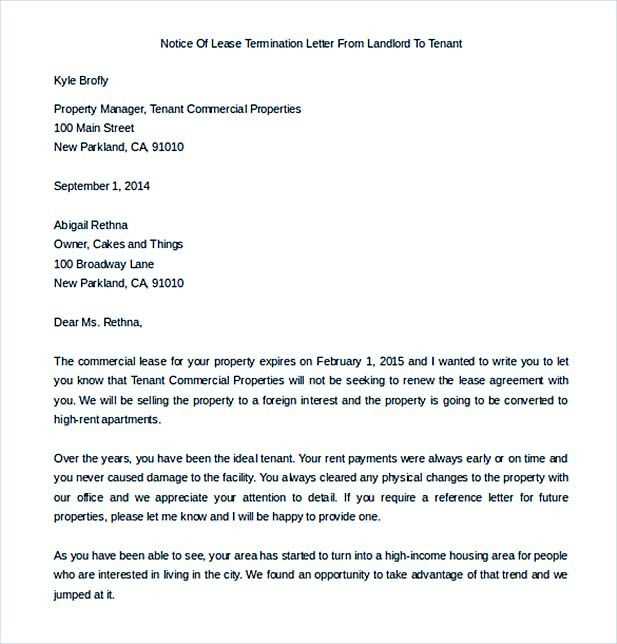
Send a clear and direct notice when you want to renew or terminate a lease agreement. If you’re offering a lease renewal, make sure to notify the tenant at least 30 days before the current lease expires. Include the new lease terms, such as rent changes or updated rules, so the tenant can make an informed decision.
If you decide not to renew the lease, provide the tenant with notice well in advance–typically 30 to 60 days before the lease term ends. Ensure the notice clearly states your intent not to renew and includes the move-out date. This gives tenants enough time to find a new home.
Lease Termination Notice
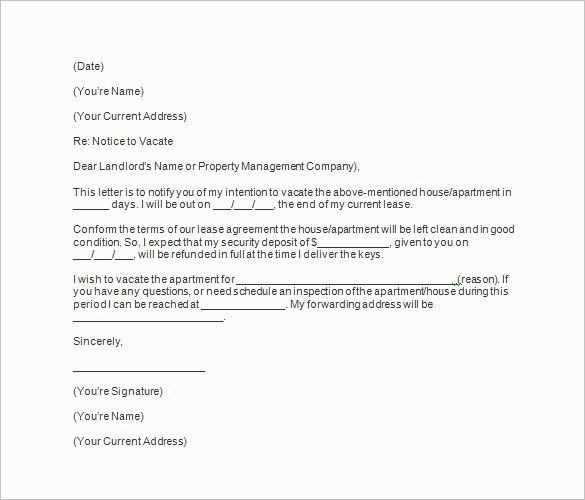
For lease termination, it’s crucial to follow the timeline set by your state’s laws. Generally, you should give 30 days’ notice if the lease is month-to-month. However, if the lease is for a fixed term and the tenant has violated terms, you may need to follow a more specific process, including providing an opportunity to fix the issue before termination.
Clear Communication
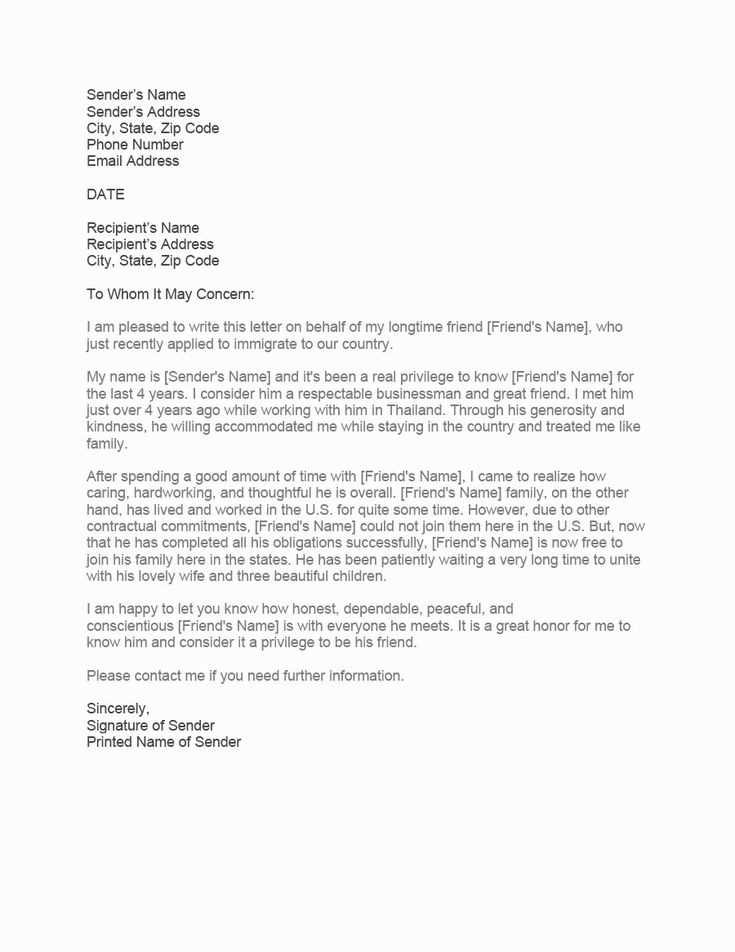
Keep your communication polite but firm. Ensure you deliver the notice through a method that confirms receipt, such as certified mail or email with acknowledgment. This protects both parties and prevents misunderstandings.
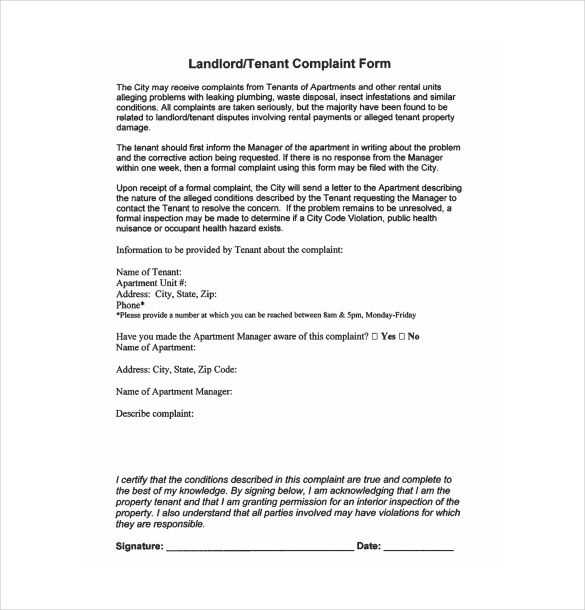
Make sure your letter adheres to local and state laws by including the necessary legal information. Always reference the relevant lease agreement clauses when addressing any violations or issues with the tenant.
- Verify the tenant’s rights and your obligations under the lease and housing regulations before sending a letter.
- Ensure the tone of your letter is respectful and avoids any language that could be construed as harassment or intimidation.
- Specify clear timeframes for any requested actions, making sure they align with legal deadlines or grace periods outlined in the lease.
- If applicable, mention any local or state laws that apply to the situation, such as rent control or repair regulations.
- Document the delivery of your letter through certified mail or another verifiable method to prove receipt if needed in the future.
Stay updated on tenant rights and landlord responsibilities to prevent any legal complications. Review your letter to ensure it does not infringe upon any legal protections or fail to provide necessary disclosures.
To ensure a clear and professional communication, use a direct approach in your landlord letter. Begin by stating the reason for the letter–whether it is for a reminder, request, or notice. Address your tenant by their name to personalize the message. Clearly outline what is expected from them and any deadlines involved.
State specific details like payment due dates, property maintenance instructions, or rent adjustments. If you are addressing an issue such as repairs or complaints, provide clear instructions on how you would like the tenant to proceed.
When making requests, keep the tone respectful and courteous. For example, instead of saying “You must,” try phrasing it as “We kindly ask you to.” This maintains a professional atmosphere while still communicating the necessary information.
Be concise in your letter. Avoid unnecessary details that can distract from the main point. Include a clear call to action, such as a request to contact you or take specific steps by a set date.
If the letter involves a legal matter or financial issue, it’s important to include relevant documentation or refer to lease clauses that support your request. This ensures transparency and prevents misunderstandings.